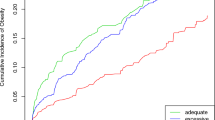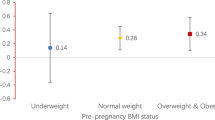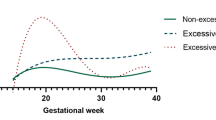Abstract
Obesity is a risk factor for gestational diabetes, whereas the role of the mother’s birth weight is more uncertain. We aimed to investigate the combined effect of mothers’ birth-weight-for-gestational-age and early pregnancy Body Mass Index (BMI) in relation to risk of gestational diabetes. Between 1973 and 2006, we identified a cohort of 323,083 women included in the Swedish Medical Birth Register both as infants and as mothers. Main exposures were mothers’ birth-weight-for-gestational-age (categorized into five groups according to deviation from national mean birth weight) and early pregnancy BMI (classified according to WHO). Rates of gestational diabetes increased with adult BMI, independently of birth-weight-for-gestational-age. However, compared to women with appropriate birth-weight-for-gestational-age [appropriate-for-gestational age (AGA); −1 to +1 SD] and BMI (<25.0), women with obesity class II-III (BMI ≥ 35.0) had an adjusted odds ratio (OR) of 28.7 (95 % confidence interval, CI 17.0–48.6) for gestational diabetes if they were born small-for-gestational-age [small for gestational age (SGA); <−2SD], OR = 20.3 (95 % CI 11.8–34.7) if born large-for-gestational-age [large-for-gestational-age (LGA); >2SD], and OR = 10.4 (95 % CI 8.4–13.0) if born AGA. Risk of gestational diabetes is not only increased among obese women, but also among women born SGA and LGA. Severely obese women born with a low or a high birth-weight-for-gestational-age seem more vulnerable to the development of gestational diabetes compared to normal weight women. Normal pre-pregnancy BMI diminishes the increased risk birth size may confer in terms of gestational diabetes. Therefore, the importance of keeping a healthy weight cannot be overemphasized.

Similar content being viewed by others
References
Bellamy L, Casas JP, Hingorani AD, Williams D. Type 2 diabetes mellitus after gestational diabetes: a systematic review and meta-analysis. Lancet. 2009;373(9677):1773–9. doi:10.1016/S0140-6736(09)60731-5.
Verier-Mine O. Outcomes in women with a history of gestational diabetes. Screening and prevention of type 2 diabetes. Literature review. Diabetes Metab. 2010;36(6 Pt 2):595–616. doi:10.1016/j.diabet.2010.11.011.
Catalano PM, Tyzbir ED, Roman NM, Amini SB, Sims EA. Longitudinal changes in insulin release and insulin resistance in nonobese pregnant women. Am J Obstet Gynecol. 1991;165(6 Pt 1):1667–72.
Solomon CG, Willett WC, Carey VJ, et al. A prospective study of pregravid determinants of gestational diabetes mellitus. JAMA, J Am Med Assoc. 1997;278(13):1078–83.
Barker DJ, Hales CN, Fall CH, Osmond C, Phipps K, Clark PM. Type 2 (non-insulin-dependent) diabetes mellitus, hypertension and hyperlipidaemia (syndrome X): relation to reduced fetal growth. Diabetologia. 1993;36(1):62–7.
Forsen T, Eriksson J, Tuomilehto J, Reunanen A, Osmond C, Barker D. The fetal and childhood growth of persons who develop type 2 diabetes. Ann Intern Med. 2000;133(3):176–82.
Barker DJ. The fetal and infant origins of adult disease. BMJ. 1990;301(6761):1111.
Seghieri G, Anichini R, De Bellis A, Alviggi L, Franconi F, Breschi MC. Relationship between gestational diabetes mellitus and low maternal birth weight. Diabetes Care. 2002;25(10):1761–5.
Innes KE, Byers TE, Marshall JA, Baron A, Orleans M, Hamman RF. Association of a woman’s own birth weight with subsequent risk for gestational diabetes. JAMA, J Am Med Assoc. 2002;287(19):2534–41.
Lithell HO, McKeigue PM, Berglund L, Mohsen R, Lithell UB, Leon DA. Relation of size at birth to non-insulin dependent diabetes and insulin concentrations in men aged 50–60 years. BMJ. 1996;312(7028):406–10.
Ludvigsson JF, Otterblad-Olausson P, Pettersson BU, Ekbom A. The Swedish personal identity number: possibilities and pitfalls in healthcare and medical research. Eur J Epidemiol. 2009;24(11):659–67. doi:10.1007/s10654-009-9350-y.
The Swedish Medical Birth Register: a summary of content and quality National Board of Health and Welfare, Stockholm, Sweden. http://www.socialstyrelsen.se/Lists/Artikelkatalog/Attachments/10655/2003-112-3_20031123.pdf (2011). Accessed 24 Feb 2011.
Lindmark G, Cnattingius S. The scientific basis of antenatal care. Report from a state-of-the-art conference. Acta Obstet Gynecol Scand. 1991;70(2):105–9.
Niklasson A, Ericson A, Fryer JG, Karlberg J, Lawrence C, Karlberg P. An update of the Swedish reference standards for weight, length and head circumference at birth for given gestational age (1977–1981). Acta Paediatr Scand. 1991;80(8–9):756–62.
Global database on Body Mass Index. World Health Organization. http://apps.who.int/bmi/index.jsp?introPage=intro_3.html (2011). Accessed 09 Nov 2011.
Teh WT, Teede HJ, Paul E, Harrison CL, Wallace EM, Allan C. Risk factors for gestational diabetes mellitus: implications for the application of screening guidelines. Aust NZ J Obstet Gynaecol. 2011;51(1):26–30. doi:10.1111/j.1479-828X.2011.01292.x.
Savvidou M, Nelson SM, Makgoba M, Messow CM, Sattar N, Nicolaides K. First-trimester prediction of gestational diabetes mellitus: examining the potential of combining maternal characteristics and laboratory measures. Diabetes. 2010;59(12):3017–22. doi:10.2337/db10-0688.
Plante LA. Low birth weight may not predict diabetes in pregnancy. Diabetes Care. 2004;27(7):1759–60.
Moses RG, Moses J, Knights S. Birth weight of women with gestational diabetes. Diabetes Care. 1999;22(7):1059–62.
Egeland GM, Skjaerven R, Irgens LM. Birth characteristics of women who develop gestational diabetes: population based study. BMJ. 2000;321(7260):546–7.
Chiavaroli V, Giannini C, D’Adamo E, de Giorgis T, Chiarelli F, Mohn A. Insulin resistance and oxidative stress in children born small and large for gestational age. Pediatrics. 2009;124(2):695–702. doi:10.1542/peds.2008-3056.
Plagemann A, Harder T, Rake A, et al. Observations on the orexigenic hypothalamic neuropeptide Y-system in neonatally overfed weanling rats. J Neuroendocrinol. 1999;11(7):541–6.
Muhlhausler BS, Adam CL, Findlay PA, Duffield JA, McMillen IC. Increased maternal nutrition alters development of the appetite-regulating network in the brain. FASEB J. 2006;20(8):1257–9. doi:10.1096/fj.05-5241fje. Official publication of the Federation of American Societies for Experimental Biology.
Heywood WE, Mian N, Milla PJ, Lindley KJ. Programming of defective rat pancreatic beta-cell function in offspring from mothers fed a low-protein diet during gestation and the suckling periods. Clin Sci (Lond). 2004;107(1):37–45. doi:10.1042/CS20030350.
Eriksson J, Forsen T, Tuomilehto J, Osmond C, Barker D. Fetal and childhood growth and hypertension in adult life. Hypertension. 2000;36(5):790–4.
Gluckman PD, Hanson MA, Beedle AS, Raubenheimer D. Fetal and neonatal pathways to obesity. Front Horm Res. 2008;36:61–72. doi:10.1159/0000115337.
Rich-Edwards JW, Colditz GA, Stampfer MJ, et al. Birthweight and the risk for type 2 diabetes mellitus in adult women. Ann Intern Med. 1999;130(4 Pt 1):278–84.
Dabelea D, Pettitt DJ, Hanson RL, Imperatore G, Bennett PH, Knowler WC. Birth weight, type 2 diabetes, and insulin resistance in Pima Indian children and young adults. Diabetes Care. 1999;22(6):944–50.
Nohr EA, Vaeth M, Baker JL, Sorensen T, Olsen J, Rasmussen KM. Combined associations of prepregnancy body mass index and gestational weight gain with the outcome of pregnancy. Am J Clin Nutr. 2008;87(6):1750–9.
Heude B, Thiebaugeorges O, Goua V, et al. Pre-pregnancy body mass index and weight gain during pregnancy: relations with gestational diabetes and hypertension, and birth outcomes. Matern Child Health J. 2011;. doi:10.1007/s10995-011-0741-9.
Fadl HE, Ostlund IK, Magnuson AF, Hanson US. Maternal and neonatal outcomes and time trends of gestational diabetes mellitus in Sweden from 1991 to 2003. Diabet Med. 2010;27(4):436–41. doi:10.1111/j.1464-5491.2010.02978.x.
Ostlund I, Hanson U. Occurrence of gestational diabetes mellitus and the value of different screening indicators for the oral glucose tolerance test. Acta Obstet Gynecol Scand. 2003;82(2):103–8.
Wong LF, Caughey AB, Nakagawa S, Kaimal AJ, Tran SH, Cheng YW. Perinatal outcomes among different Asian-American subgroups. Am J Obstet Gynecol. 2008;199(4):382e1–6. doi:10.1016/j.ajog.2008.06.073.
Asbee SM, Jenkins TR, Butler JR, White J, Elliot M, Rutledge A. Preventing excessive weight gain during pregnancy through dietary and lifestyle counseling: a randomized controlled trial. Obstet Gynecol. 2009;113(2 Pt 1):305–12. doi:10.1097/AOG.0b013e318195baef.
Luoto R, Kinnunen TI, Aittasalo M, et al. Primary prevention of gestational diabetes mellitus and large-for-gestational-age newborns by lifestyle counseling: a cluster-randomized controlled trial. PLoS Med. 2011;8(5):e1001036. doi:10.1371/journal.pmed.1001036.
Acknowledgments
The study was supported from the European Union’s Seventh Framework Programme (FP/2007-2011) under grant agreement No. 259679.
Conflict of interest
The authors declare that they have no conflict of interest.
Author information
Authors and Affiliations
Corresponding author
Rights and permissions
About this article
Cite this article
Lagerros, Y.T., Cnattingius, S., Granath, F. et al. From infancy to pregnancy: birth weight, body mass index, and the risk of gestational diabetes. Eur J Epidemiol 27, 799–805 (2012). https://doi.org/10.1007/s10654-012-9721-7
Received:
Accepted:
Published:
Issue Date:
DOI: https://doi.org/10.1007/s10654-012-9721-7




